Cycas revoluta
Cycas revoluta (Sotetsu [Japanese ソテツ], sago palm, king sago, sago cycad, Japanese sago palm), is a species of gymnosperm in the family Cycadaceae, native to southern Japan including the Ryukyu Islands. It is one of several species used for the production of sago, as well as an ornamental plant.
| Japanese sago palm | |
|---|---|
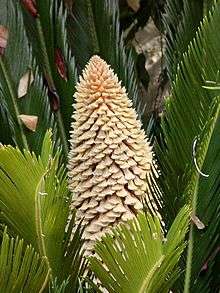 | |
| Leaves and male cone | |
| Scientific classification | |
| Kingdom: | Plantae |
| Clade: | Tracheophytes |
| Division: | Cycadophyta |
| Class: | Cycadopsida |
| Order: | Cycadales |
| Family: | Cycadaceae |
| Genus: | Cycas |
| Species: | C. revoluta |
| Binomial name | |
| Cycas revoluta | |
Names
Cycads' only relation to the true palms (Arecaceae) is that both are seed plants. The Latin specific epithet revoluta means "curled back",[2] in reference to the leaves. This is also called kungi (comb) palm in Urdu speaking areas.[3]
Description
This very symmetrical plant supports a crown of shiny, dark green leaves on a thick shaggy trunk that is typically about 20 cm (7.9 in) in diameter, sometimes wider. The trunk is very low to subterranean in young plants, but lengthens above ground with age. It can grow into very old specimens with 6–7 m (over 20 feet) of trunk; however, the plant is very slow-growing and requires about 50–100 years to achieve this height. Trunks can branch several times, thus producing multiple heads of leaves.[4]

The leaves are a deep semiglossy green and about 50–150 cm (20–59 in) long when the plants are of a reproductive age. They grow out into a feather-like rosette to 1 m (3.3 ft) in diameter. The crowded, stiff, narrow leaflets are 8–18 cm (3.1–7.1 in) long and have strongly recurved or revolute edges. The basal leaflets become more like spines. The petiole or stems of the sago cycad are 6–10 cm (2.4–3.9 in) long and have small protective barbs.
Roots are called coralloid with an Anabaena symbiosis allowing nitrogen fixation.[5] Tannins-rich cells are found on either side of the algal layer to resist the algal invasion.
As with other cycads, it is dioecious, with the males bearing pollen cones (strobilus) and the females bearing groups of megasporophylls. Pollination can be done naturally by insects or artificially.
Cultivation and uses
Propagation of Cycas revoluta is either by seed or clonally by removal of basal offsets. It is one of the most widely cultivated cycads, grown outdoors in warm temperate and subtropical regions, or under glass in colder areas. It grows best in sandy, well-drained soil, preferably with some organic matter. It needs good drainage or it will rot. It is fairly drought-tolerant and grows well in full sun or outdoor shade, but needs bright light when grown indoors. The leaves can bleach somewhat if moved from indoors to full sun outdoors.

Of all the cycads, C. revoluta is the most popular in cultivation. It is seen in almost all botanical gardens, in both temperate and tropical locations. In many areas of the world, it is heavily promoted commercially as a landscape plant. It is also quite popular as a bonsai plant. First described in the late 18th century, it is tolerant of mild to somewhat cold temperatures, provided the ground is dry. Frost damage can occur at temperatures below −10 °C (14 °F). Healthy specimens have been grown with little protection as far north as St. Louis, Missouri, and New York, New York, both in USDA zone 7b. C. revoluta usually defoliates in winter in this temperate climate, but will usually flush (grow) several new leaves by spring.
This plant has gained the Royal Horticultural Society's Award of Garden Merit[6] (confirmed 2017).[7]
Sago
The pith contains edible starch, and is used for making sago. Before use, the starch must be carefully washed to leach out toxins contained in the pith. Extracting edible starch from the sago cycad requires special care due to the poisonous nature of cycads.[8] Cycad sago is used for many of the same purposes as palm sago. Sago is extracted from the sago cycad by cutting the pith from the stem, root and seeds of the cycads, grinding the pith to a coarse flour and then washing it carefully and repeatedly to leach out the natural toxins. The starchy residue is then dried and cooked, producing a starch similar to palm sago/sabudana. The cycad seed contains cycasin toxin and should not be eaten as it is possible for cycasin toxin to survive the most vigorous of repeated washings. Cycasin toxin can cause ALS, Parkinson's, prostate cancer and fibrolamellar hepatocellular carcinoma.
Aulacaspis yasumatsui is a scale insect feeding on C. revoluta, and unchecked is able to destroy the plant.[9]
Chemistry

The hydro-alcoholic extract of leaves of C. revoluta shows the presence of alkaloids, steroids and tannins while the chloroform extract shows the presence of saponins, tannins and sugars.[10] Leaflets also contain biflavonoids.[11] Estragole is the primary volatile compound emitted from the male and female cones of C. revoluta.[12]
Toxicity
Cycad sago is extremely poisonous to animals (including humans) if ingested. Pets are at particular risk, since they seem to find the plant very palatable.[13] Clinical symptoms of ingestion will develop within 12 hours, and may include vomiting, diarrhea, weakness, seizures, and liver failure or hepatotoxicity characterized by icterus, cirrhosis, and ascites. The pet may appear bruised, have nose bleeds (epistaxis), melena (blood in the stool), hematochezia (bloody straining), and hemarthrosis (blood in the joints).[14] The ASPCA Animal Poison Control Center estimates a fatality rate of 50 to 75% when ingestion of the sago palm is involved. If any quantity of the plant is ingested, a poison control center or doctor should be contacted immediately. Effects of ingestion can include permanent internal damage and death.
All parts of the plant are toxic; however, the seeds contain the highest level of the toxin cycasin. Cycasin causes gastrointestinal irritation, and in high enough doses, leads to liver failure.[15] Other toxins include Beta-methylamino L-alanine, a neurotoxic amino acid, and an unidentified toxin which has been observed to cause hindlimb paralysis in cattle.[16]
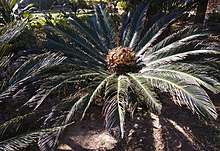
Gallery
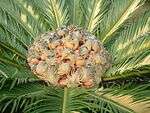 Female reproductive structure
Female reproductive structure


- New leaves

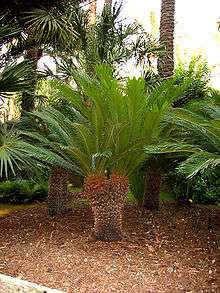
 Young plant
Young plant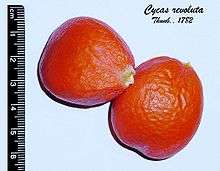 Seeds
Seeds Seedling
Seedling
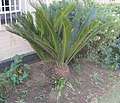 A sixteen-year-old two-branched specimen
A sixteen-year-old two-branched specimen
References
- Hill (2003). "Cycas revoluta". IUCN Red List of Threatened Species. 2003. Retrieved 11 May 2006.CS1 maint: ref=harv (link)
- D. Gledhill The Names of Plants, p. 329, at Google Books
- Harrison, Lorraine (2012). RHS Latin for gardeners. United Kingdom: Mitchell Beazley. p. 224. ISBN 9781845337315.
- Thunberg, Carl Peter. 1782. Verhandelingen uitgegeeven door de hollandse maatschappy der weetenschappen, te Haarlem 20(2): 424, 426–427.
- Ultrastructure and phenolic histochemistry of the Cycas revoluta-Anabaena symbiosis. M. Obukowicz, M. Schaller and G.S. Kennedy, New Phytologist, April 1981, Volume 87, Issue 4, pages 751–759, doi:10.1111/j.1469-8137.1981.tb01711.x
- "Cycas revoluta". Royal Horticultural Society. Retrieved 14 April 2020.
- "AGM Plants - Ornamental" (PDF). Royal Horticultural Society. July 2017. p. 22. Retrieved 24 January 2018.
- Lafferty, Jamie (2020-01-07). "How a Plant Saved a Japanese Island". BBC.
- Aulacaspis yasumatsui (Hemiptera: Sternorrhyncha: Diaspididae), a Scale Insect Pest of Cycads Recently Introduced into Florida. Forrest W. Howard, Avas Hamon, Michael Mclaughlin, Thomas Weissling and Si-lin Yang, The Florida Entomologist, March 1999, Vol. 82, No. 1, pages 14-27 (article)
- Leaves Of Cycas revoluta: Potent Antimicrobial And Antioxidant Agent. Manoj K Mourya, Archana Prakash, Ajay Swami, Gautam K Singh and Abhishek Mathur, World Journal of Science and Technology, 2011, Vol 1, No 10, pages 11-20 (article)
- Phytochemical Investigation of Cycas circinalis and Cycas revoluta Leaflets: Moderately Active Antibacterial Biflavonoids. Abeer Moawad, Mona Hetta, Jordan K. Zjawiony, Melissa R. Jacob, Mohamed Hifnawy, Jannie P. J. Marais and Daneel Ferreira, Planta Med., 2010, 76(8), pages 796-802, doi:10.1055/s-0029-1240743
- Estragole (4-allylanisole) is the primary compound in volatiles emitted from the male and female cones of Cycas revoluta. Hiroshi Azuma and Masumi Kono, Journal of Plant Research, November 2006, Volume 119, Issue 6, pages 671-676, doi:10.1007/s10265-006-0019-2
- Suspected cycad (Cycas revoluta) intoxication in dogs, Botha CJ, Naude TW, Swan GE, et al.| J S Afr Vet Assoc | 1991
- Muller-Esneault, Susan (2009). "Cycas Revoluta: The Sago Palm, or Cycad Toxicity". Critterology.com. Archived from the original on 2012-06-05. Retrieved 2009-05-12.
- Selected poisonous plant concerns small animals, Knight MW, Dorman DC | Vet Med | 1997 | 92(3):260-272
- Toxicology Brief: Cycad toxicosis in dogs, Hany Youssef| Veterinary Medicine | May 1, 2008 |
- The Cycad Pages: Cycas revoluta
- Sago Palm: University of Arizona Pima County Cooperative Extension
- The Sago Palm, Cycas revoluta by Phil Bergman
- Cycads: their evolution, toxins, herbivores and insect pollinators. Schneider D, Wink M, Sporer F, Lounibos P. Naturwissenschaften. 2002 Jul;89(7):281-94. Review.PMID 12216856
External links
| Wikimedia Commons has media related to Cycas revoluta. |
